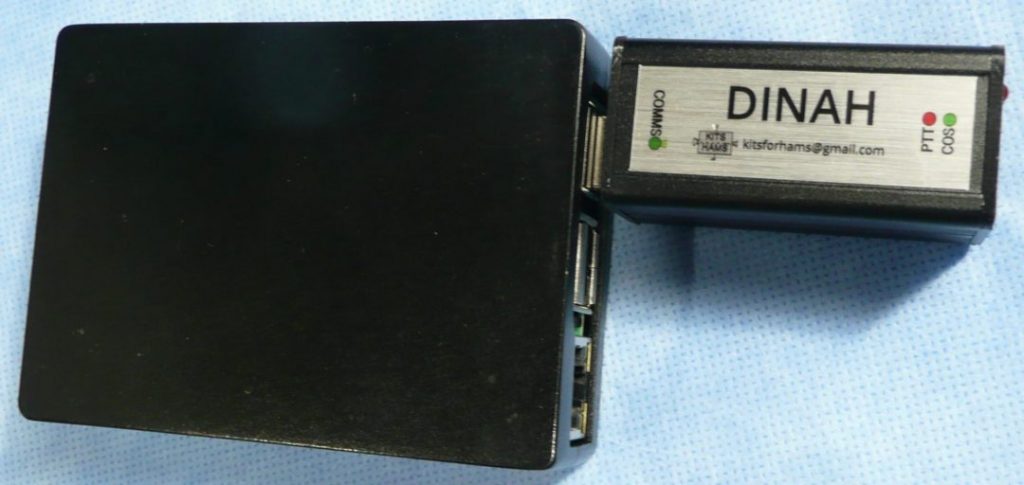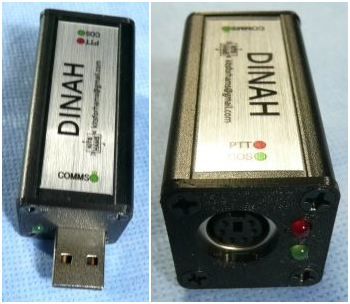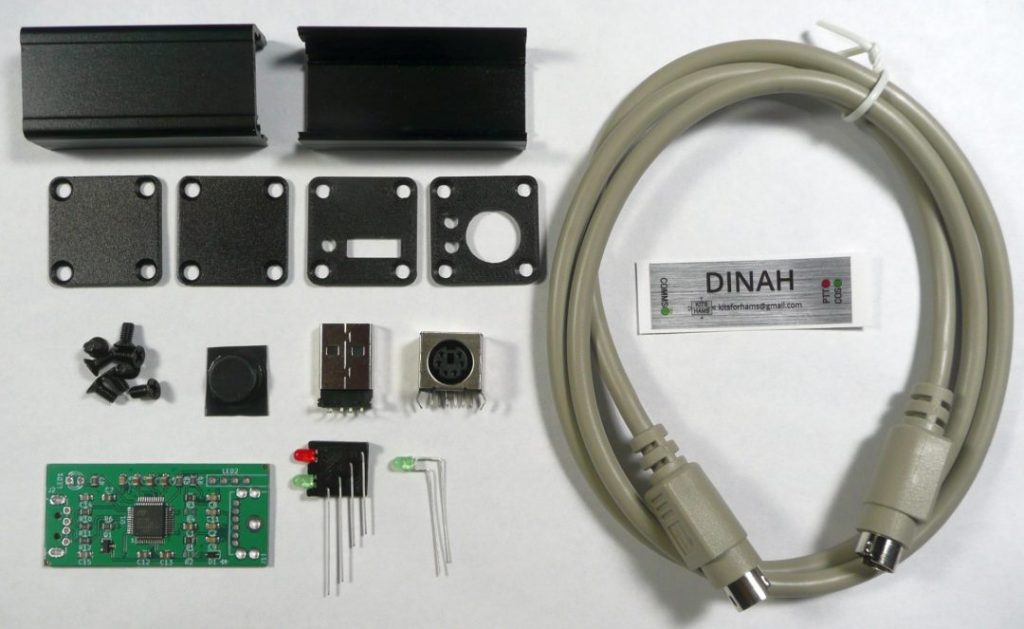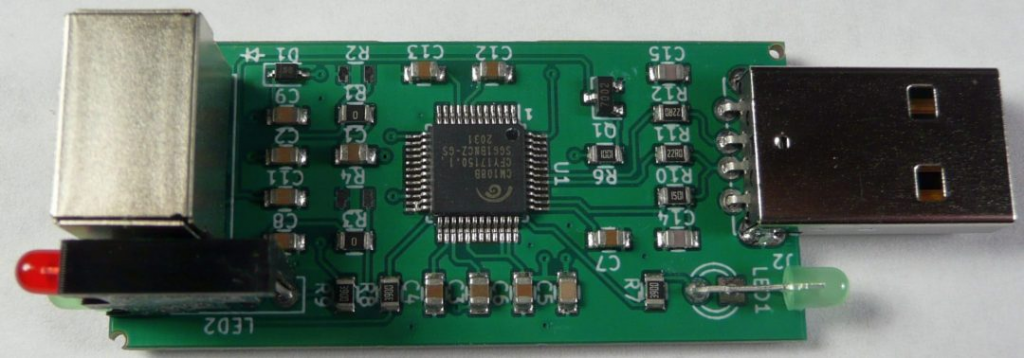
Overview
DINAH (DIN connector based Allstar interface for Hams) is a kit construction project designed by N8AR that implements a radio interface to a Raspberry Pi running Allstar software. An Allstar node can be easily and quickly implemented using DINAH, a UHF or VHF radio with a packet (or data) interface, an off-the-shelf miniDIN cable and a Raspberry Pi running the Allstar program.
It can also be used with the Dire Wolf software. New to version 4 of DINAH, a 3 position solder pad jumper (JP1) is provided on the bottom of the board to select between 1200 (default) and 9600 baud. Also the connection on a normally closed second solder pad jumper (JP3) can be cut to disconnect the COS signal from the radio.
DINAH is available completely assembled or as a very simple construction project (install 4 through-hole parts and complete final assembly).
DINAH measures only 2 inches long and 1 inch square (50mm by 25mm). It has a built-in male USB connector to plug into a Raspberry Pi (2 or 3) and a green blinking “Activity” LED on one end of the enclosure. On the other end there is a 6 pin female miniDIN connector (to connect to the 6 pin miniDIN connector on your radio) plus red (PTT) and yellow (COS) status LEDs .
The USB connector on DINAH is located to permit access to the two adjacent USB connectors on the Pi when DINAH is plugged into the lower connector on the outer column of the Pi3 USB connectors.

Unlike the full-featured and more flexible Allstar radio interface solutions from sources such as TechnoByGeorge, Repeater Builder, DMK , Masters Communications, CustomComms, etc – DINAH is designed specifically to interface to the 6 pin DIN connector commonly used for the packet (or data) connection on ham radio VHF and UHF radios. Because this packet interface is fairly standard, DINAH requires no additional gain or potentiometers in the audio paths. Required audio gain settings can be achieved from within the Allstar program. An inexpensive standard off-the-shelf cable with 6 pin miniDIN male connectors on both ends is used to connect DINAH to the radio. Thus the builder does not have to build an interface cable. However, the DINAH PCB (which uses 0805 surface mount parts) includes optional jumpers and SMT parts locations to permit the builder to insert fixed attenuation in the audio paths, select 1200 or 9600 audio and disable COS for additional interfacing flexibility required for using DINAH with other software such as DireWolf.
Key Features
- Small, portable, USB-powered
- Pre-assembled SMD board simplifies construction
- Uses CM119B or CM108B USB audio codec integrated circuit
- Rugged, RFI-resistant metal enclosure
- RFI filter capacitors
- Uses standard low-cost 6 pin male-to-male miniDIN cable
- Interfaces to standard packet (data) interface on many VHF/UHF radios
- 3D printed plastic enclosure ends minimize mechanical assembly effort
- Blank metal end caps included for modification and use in the event of RFI issues
- Jumpers and extra parts locations facilitate custom configurations
Compatible Radios
The 6-Pin miniDIN jack “Packet” or “Data” interface is a standard used by all the Japanese ham equipment manufacturers. Many current all-band all-mode and VHF/UHF transceivers are equipped with this jack. Also, some radios are electrically compatible with the standard but use a different connector. The following document contains a list of radios which should be compatible with SHARI according to published documentation. Bold text indicates a radio that has been verified to work with DINAH.
DINAH Kit Parts
All parts required to assemble the DINAH USB-A kit are provided as shown in the next photo:
Note: The green LED (COS) below the red LED (PTT) in the LED array has been changed to a yellow LED.

Construction
DINAH uses a single circuit board. The board contains surface mount (SMD) parts as well as four through-hole parts (DIN connector, USB connector, LED and LED array).

The DINAH USB-A kit contains all of the parts required to build the device as well as the 3 foot miniDIN cable. All the surface mount parts have been installed on the PC board. The builder only has to solder four through-hole parts to the board. The kit includes blank metal end caps for the enclosure (you add the required cutout and holes) as well as a set of plastic 3D printed end caps which can be used instead of the metal end caps (at the builders discretion). It does not include the Raspberry Pi (2 or 3), the Pi power supply or a case for the Pi.
Construction Manual
A comprehensive step-by-step construction/assembly manual is supplied as a download from this site (no printed manual is supplied). Click on the following link:
Setup Guide
A guide by KG8MM to setup and configure the HamVOIP Allstar distribution for DINAH can be downloaded by clicking on the following link:
Ordering Information
DINAH USB-A is available as a simple parts kit for $55 (install 4 through-hole parts and complete final assembly) or completely assembled for $65. Shipping is $9 via USPS Mail. Payment via Paypal is preferred. Click on the button below to Download a PDF fillable order form.
Complete the order form and email it as an attachment to kits4hams@gmail.com. We will check your order, add it to our waitlist and notify you with an approximate waiting time, and then send you a invoice when it is ready to ship.
Support
Support of DINAH is provided via the DINAH group at DINAH Group
The purpose of the DINAH group is to serve as the main hardware support source and discussion group for hams building and using the DINAH Allstar Radio Interface. Support of the Allstar distribution you install in your Raspberry Pi and use in conjunction with DINAH is best obtained from the source of the Allstar distribution (i.e. allstarlink.org or hamvoip.org). You need to join the DINAH group in order to download files and post messages.
